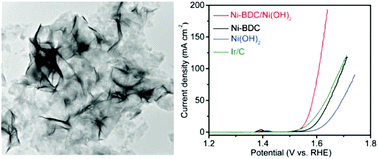A 2D metal–organic framework/Ni(OH)2 heterostructure for an enhanced oxygen evolution reaction†
Abstract
2D metal–organic frameworks (MOFs) are widely regarded as promising electrocatalysts for the oxygen evolution reaction (OER). This results from their inherent properties such as a large portion of surface coordinatively unsaturated metal atoms, rapid mass transfer and enhanced conductivity. However, 2D MOFs have a strong tendency to aggregate, which severely limits their potential application in the OER. Here, novel 2D Ni-BDC/Ni(OH)2 (BDC stands for 1,4-benzenedicarboxylate, C8H4O4) hybrid nanosheets are synthesized via a facile sonication-assisted solution method. Because of the rational material design, the large surface area of Ni-BDC is maintained. Significantly, after coupling, the electronic structure of Ni atoms in the Ni(OH)2 component is well modified, leading to the generation of Ni cations with higher oxidation states, which are desirable for the OER. As-prepared Ni-BDC/Ni(OH)2 exhibits high activity, favorable kinetics and strong durability towards the OER. Specifically, the OER current density of Ni-BDC/Ni(OH)2 is 82.5 mA cm−2 at 1.6 V versus a reversible hydrogen electrode (RHE), which is significantly greater than those of Ni-BDC (5.5 times), Ni(OH)2 (20.6 times) and Ir/C (3.0 times). Moreover, the sonication-assisted method developed in this work can be readily adapted for the preparation of various 2D MOF-based hybrid functional materials.



 Please wait while we load your content...
Please wait while we load your content...